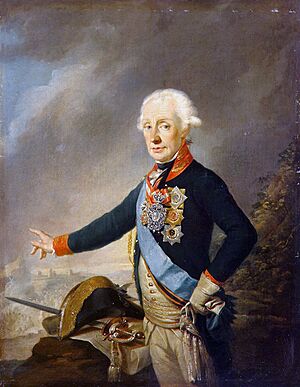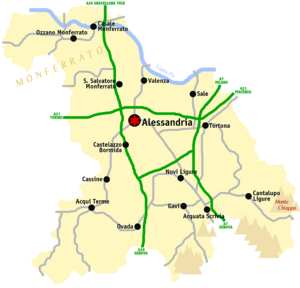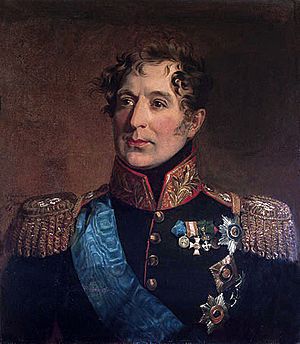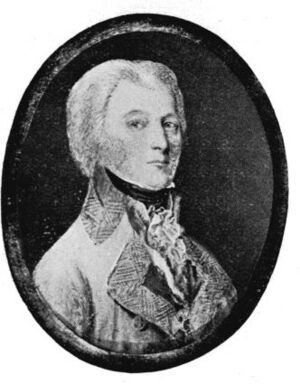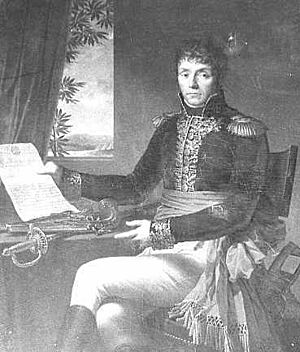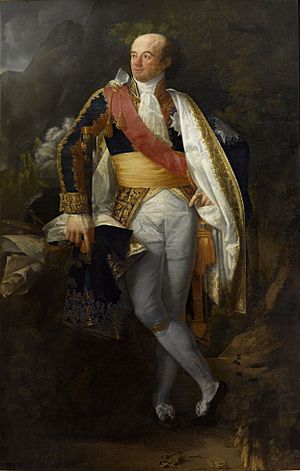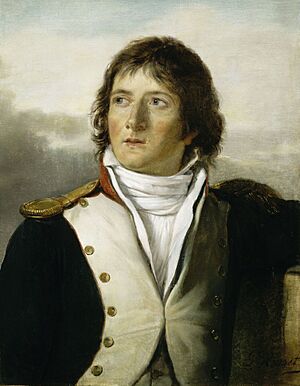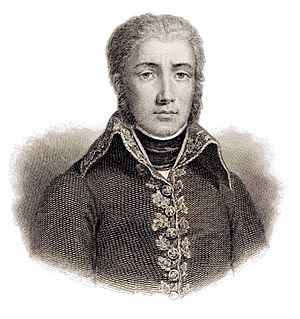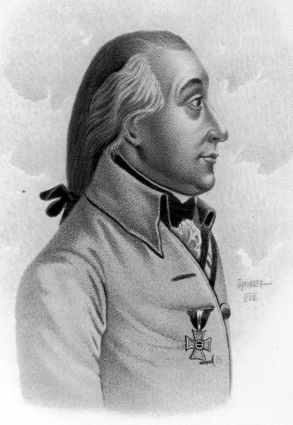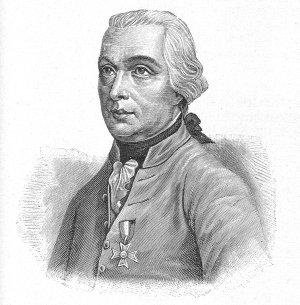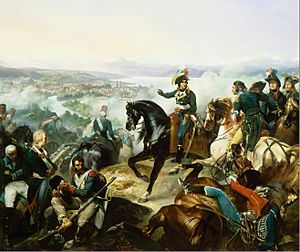Battle of Novi (1799) facts for kids
Quick facts for kids Battle of Novi (1799) |
|||||||
|---|---|---|---|---|---|---|---|
| Part of the Italian campaigns in the War of the Second Coalition | |||||||
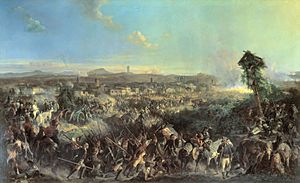 Battle of Novi, by Alexander Kotzebue |
|||||||
|
|||||||
| Belligerents | |||||||
|
|||||||
| Commanders and leaders | |||||||
| Strength | |||||||
|
|
34,930 to 37,252 40+ guns |
||||||
| Casualties and losses | |||||||
| 8,000–9,000 ...another calculations Details:
3 guns
|
9,663–12,000 ...another calculations Details:
37 guns
4 standards |
||||||
The Battle of Novi was a major fight on August 15, 1799. It took place near Novi Ligure in Italy. In this battle, armies from Austria and Russia, led by Field Marshal Alexander Suvorov, fought against the French army. The French were first led by General Barthélemy Catherine Joubert. Sadly, Joubert was killed early in the battle. After his death, Jean Victor Marie Moreau took charge of the French forces.
The battle was long and very bloody. The combined Austrian and Russian forces eventually broke through the French defenses. This forced the French to retreat in a disorganized way. During the retreat, French commanders Catherine-Dominique de Pérignon and Emmanuel Grouchy were captured. Novi Ligure is about 58 kilometers (36 miles) north of Genoa. This battle was part of the War of the Second Coalition, which was a bigger conflict within the French Revolutionary Wars. Novi was a strong place to defend because it was on steep hills. An old fortress wall from the 1400s also helped protect the city. Even though the wall was damaged, the French had blocked all the broken parts.
In 1799, Russian and Austrian armies moved through the Po River valley. They took back lands that Napoleon Bonaparte had captured earlier in 1796. The French troops in Italy had suffered big defeats in battles like Magnano, Cassano, and the Trebbia. After these losses, the French and their Italian allies retreated to Genoa. A new French government put Joubert in charge of the Army of Italy. They ordered him to attack. So, the French army moved north over the mountains and gathered on high ground at Novi Ligure on August 14. Joubert was surprised to see that a large enemy force was already very close. The next morning, Austrian troops under Paul Kray attacked the French left side, and the battle began.
After a short delay, Suvorov sent Russian troops to attack the center. Austrian forces under Michael von Melas attacked the French right side. Kray's troops lost many soldiers. By evening, the French army was badly beaten. Their control over the Italian Riviera became much weaker. Cavalry (soldiers on horseback) were not very useful in this hilly area. Both sides used them mostly for chasing the enemy after the battle. After their victory, the Allied leaders made a mistake. They sent Suvorov's Russian troops to Switzerland, which turned out to be a bad decision.
Contents
Why the Battle Happened
The fighting in Italy in 1799 started with the Battle of Verona in March. These were costly but didn't decide much. Then, at the Battle of Magnano in April, the Austrian army won against the French. The French lost many soldiers and cannons. Their commander, Barthélemy Louis Joseph Schérer, was very upset and asked to be replaced.
On April 15, 1799, the experienced Russian general Alexander Suvorov took command of the combined Austrian and Russian army in Italy. Suvorov defeated the French, now led by Jean Victor Marie Moreau, at the Battle of Cassano in April. Later, in June, Suvorov's army also defeated Jacques MacDonald's French army at the Battle of the Trebbia. The Allies lost 5,500 soldiers, but the French lost 16,500, including 7,000 prisoners.
After these wins, the Allied forces successfully captured several important fortresses. They took Peschiera del Garda in May, Milan in May, and Turin in June. Suvorov and his Austrian allies had pushed the French out of almost all of Italy. Meanwhile, Archduke Charles, Duke of Teschen also defeated a French army in Switzerland.
By late June, Suvorov moved his main army west to help with the sieges of Alessandria and Tortona. He wanted to push the French out of Genoa and the Italian Riviera. However, orders from Vienna told him to wait. The Austrian Emperor and his foreign minister wanted the fortresses captured first. They were worried Russia might try to take Genoa and Tuscany, which Austria considered its own. Suvorov was annoyed by these orders from far away.
The many French military losses made people lose faith in the French Directory, which was the government. A change in government happened in June. The French government hoped Barthélemy Catherine Joubert could fix the situation. He became the new commander of the Army of Italy. Joubert was a skilled general, and people thought he wasn't interested in politics, so he wasn't a threat to the government. When Joubert arrived on August 4, Moreau stepped aside and offered to help him.
The Allies successfully captured Alessandria in July and Mantua in July. These victories freed up 30,000 Allied soldiers for fighting. Suvorov placed Austrian troops to guard western Piedmont and the passes into Switzerland. Other troops watched the area southeast of Genoa. The rest of Suvorov's army was near Alessandria and Tortona.
The French Army of Italy had good generals. Catherine-Dominique de Pérignon led the left side, and Laurent Gouvion Saint-Cyr led the right side. Joubert's generals wanted to wait for another French army to arrive around August 20 before attacking. But Joubert felt he had to follow the government's orders to attack right away. Saint-Cyr's troops moved north through the Bocchetta Pass and Gavi. They surrounded a castle held by Austrians. Pérignon's troops marched further, pushing some Austrian soldiers out of Terzo. Saint-Cyr reached Novi Ligure on August 13. Suvorov chose not to attack yet, hoping to draw the French into the open plains where his cavalry and cannons would be more effective.
Joubert had hoped he was only facing about 8,000 enemies. But he was shocked to see at least 36,000 enemy soldiers, including Kray's troops, in the plains below. Both Pérignon and Saint-Cyr advised retreating. Joubert decided to wait until the next day to make a final decision. Suvorov thought the French would come down into the plains. He planned for Kray and 27,000 soldiers to attack their left side. Russian troops would attack their right side. The goal was for these two forces to meet behind the French army.
Military Forces Involved
Allied Army Strengths
The Allied army was a mix of Austrian and Russian forces. General Kray's Austrian troops were divided into two main groups. One group, led by General Ott, had about 10,885 soldiers, mostly infantry. The other group, led by General Bellegarde, had about 13,520 soldiers, including infantry and cavalry. There was also a smaller group of about 3,015 soldiers under Seckendorff. In total, Kray commanded about 27,420 troops.
On the Allied left side, General Melas commanded an Austrian division of about 8,575 soldiers. This division included many grenadiers (specialized infantry) and some cavalry.
The Russian forces, led by General Derfelden, had about 15,552 soldiers. This included a main division, another division under General Miloradovich, and an advance group led by General Bagration. Bagration's group had about 5,705 soldiers, including infantry and Cossack cavalry. In total, Suvorov's combined Austrian and Russian army had about 44,347 infantry and 7,200 cavalry, making a total of 51,547 soldiers.
French Army Strengths
The French army, led by Joubert, had between 34,930 and 37,252 soldiers. This included about 32,843 to 35,487 infantry and 1,765 to 2,087 cavalry. They also had over 40 cannons. The French soldiers were tired, hungry, and thirsty because their supplies were not reaching them. Some were even eating grass and leaves to survive.
The French army was divided into two main parts. Pérignon's part on the left included divisions led by Grouchy and Louis Lemoine, plus reserves. Grouchy's division had about 5,620 men, and Lemoine's had about 6,410. Saint-Cyr's part on the right included divisions led by Pierre Garnier de Laboissière, François Watrin, and Jean Henri Dombrowski. Laboissière's division had about 3,645 to 3,976 men. Watrin's division had between 4,535 and 6,040 soldiers. Dombrowski's division had about 2,130 to 2,340 troops, including Polish soldiers.
The Battle Unfolds
Joubert hadn't planned to fight at Novi Ligure. However, his troops were in a good defensive spot. They held high ground in a curve, from Serravalle on the right to Pasturana on the left. Novi itself was in the middle, protected by an old wall and ditch. A weak point was that deep ravines behind them could block a retreat.
Before dawn, Kray's Austrian forces on the Allied right side began to move. They attacked the French lines around 3:20 am. This surprised the French, who quickly formed up. As daylight came, the Allies saw French infantry on the high ground. Instead of attacking a moving army's side, the Austrians were making a direct attack on a strong position.
On the far right of the French line, Dombrowski's division was blocking the Austrians at Serravalle Castle. Next was Watrin's division, positioned in the low ground east of Novi. Gardanne's brigade held Novi, and the rest of Laboissière's division was on the heights behind the town. Further left were Lemoine's and then Grouchy's divisions. Reserves supported the far left.
The Austrians attacked the steep, vineyard-covered slopes. At first, they had some success. But the difficult terrain forced them into columns, making them easier targets. Pérignon sent reserves to help Grouchy, and Saint-Cyr sent troops to help Lemoine. Moreau took charge of the French center. During this intense fighting, Joubert was hit and killed while leading a counterattack. Despite heavy losses, the Austrian infantry bravely pushed forward repeatedly. When they reached the top and tried to spread out, French counterattacks pushed them back. Eventually, the Austrian columns were defeated, and Kray's entire force fell back to the bottom of the hills to regroup.
By 9:00 am, Kray reorganized his troops and received orders from Suvorov to attack again. The Austrians attacked the heights once more but were again defeated. While some French reserves helped push back the Austrians, General Partouneaux unwisely charged into the plain. His troops were scattered by Austrian cavalry, and Partouneaux was captured. After this second failed attack, Kray used 40 cannons to bombard the French. But he refused to attack again until the rest of the Allied army joined the fight. Suvorov's original plan to surround a moving French army was now off track.
Suvorov realized he needed to use all his soldiers. Bagration's Russian troops finally attacked Novi at 10:00 am. They faced heavy cannon fire. The Russians pushed back the French skirmishers but were stopped by Novi's city wall. They moved right and ran into French troops defending the heights. French soldiers from Novi and the right flank also attacked them. Miloradovich's Russian division joined the fight, but every Russian attack on the French center failed. Bagration's Cossacks were useful for luring French skirmishers into the open and then capturing or killing them.
Later, Derfelden's Russian division arrived and launched another attack near Novi. Kray's forces attacked again but also stalled. Around 11:30 am, Suvorov ordered the Allied left wing, led by Melas, to advance. Melas, however, decided not to attack Novi directly. Instead, he carefully checked the ground and chose to attack the French right flank. His troops moved along the Scrivia River, with some guarding against French threats from Serravalle.
Around 3:00 pm, the latest Austro-Russian attack on the heights was pushed back. By this time, Watrin had positioned his French division on the hills east of Novi. Austrian grenadiers attacked Watrin's position three times but couldn't break through. Meanwhile, other Austrian grenadiers approached Watrin's right side, threatening to surround him. Faced with these new attacks, Watrin's division began to fall apart. Saint-Cyr sent in a counterattack, which stopped the Austrians and captured their wounded general, Lusignan. By 5:00 pm, Watrin's troops were finally defeated by the larger numbers and retreated. On the other side of the battlefield, Kray attacked again between 3:00 and 4:00 pm.
Around 5:30 pm, the entire French position started to collapse. Austrian grenadiers drove the French from the crest near Novi. Russian and Austrian troops broke into Novi at about the same time, pushing out most of Gardanne's men. Laboissière's division managed to escape after Watrin's men. But at this point, the French army split into two parts and didn't reunite for three days. As the French left side began to pull back, the Allies sent in their cavalry to finish the job. The French had to squeeze through the narrow streets of Pasturana and a gorge, where a small Austrian force was waiting.
The entire French left wing had to get through this blocked area. The Russians took no prisoners, killing every Frenchman they caught. If a French soldier survived, it was because Austrian troops captured him. In the chaos, Grouchy tried to rally his men but was cut down and captured. Pérignon was also captured after being wounded three times. Many other French soldiers and cannons were captured, mostly in the bottleneck at Pasturana. As night fell, the French army fled, and the exhausted Allies stopped. Near midnight, some French soldiers were found hiding in Novi, and the Russians went through the town again. After achieving their goal, they began looting, and Suvorov had to order his drummers to call assembly to stop the pillaging.
Battle Outcomes
Years later, when asked about Suvorov, the French general Moreau said: "What can you say of a general so determined to a superhuman degree, and who would perish himself and let his army perish to the last man rather than retreat a single pace."
Historians call Novi "one of the bloodiest battles of the era." The Allies lost about 8,000 to 9,000 soldiers, including those killed, wounded, or missing. This included about 7,000 dead or wounded and 2,000 prisoners or missing. They also lost 3 cannons. Several Russian generals were wounded. The French lost even more, with about 9,663 to 12,000 casualties. This included about 7,000 dead or wounded and 4,000 prisoners or missing. The Allies also captured 37 cannons and 4 standards (flags).
After the battle, the French left wing escaped the gorge and quickly left the battlefield. However, the right wing had trouble retreating because their escape routes were blocked. Saint-Cyr eventually managed to push the Austrians out of the way using Watrin's division. Suvorov brought up more troops but didn't chase the French. He still wanted to push the French out of Genoa, but new orders soon arrived.
On August 25, Suvorov's plans to conquer Liguria were stopped. New instructions from the Austrian Emperor and the Russian Czar ordered Suvorov to take command of a new Russian army in Switzerland. This army would join another Russian army and invade France. However, the timing of this plan failed. The Austrian Archduke Charles left Switzerland too early, and Suvorov arrived too late. The French general André Masséna ruined the Allied plan when he defeated the Russian army in Switzerland in September 1799.
See also


